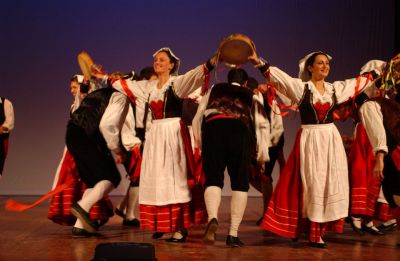At the typical Italian American wedding reception, party-goers dance in a circle around the newlyweds to a fast and upbeat tempo joyously welcoming the couple into their new life. This is the traditional southern Italian folk dance called the tarantella.
Depending on the region of Italy, the tarantella is known by different names. In Salento, it is called pizzica (which literally translates as “bite”), in Campania, tammurriata. During our trip to Salice Salentino, our host, Enzo, took us to the small town of Galatina and the chapel of St. Paul, the town’s patron saint, to learn of the tarantella’s illustrious history.
Legend has it that St. Paul, traveling through the town of Galatina with St. Peter, imbued a local man and his descendants with the power to heal those bitten by the tarantula spider. He blessed the water in the well of the courtyard nearby. The tarantella would begin in the chapel or the victim’s home, with dancing and music spilling out onto the public square; the tarantata (spider bite victim) eventually falling to the ground exhausted and hopefully freed of the venom by the intercession of St. Paul. They would then drink the holy water assuming that grace had been obtained. Until recent years, believers would return to the chapel on June 28 and 29, feast days of Saints Peter and Paul, to perform the ritual dances and give thanks for graces given.
The tarantella’s roots can be traced back to ancient Greek mythology and Dionysus, the much-venerated god of wine and drunkenness. In 186 BC, the dance went underground when the Roman Senate declared the suppression of Bacchanalian rites. The tarantella reappeared much later under the guise of emergency therapy for spider bite victims. Eventually, this pagan rite would be adapted by the Catholic Church.
In the province of Taranto in the Apulia region, it is said that during the harvest, field workers bitten by the wolf spider or tarantula would be afflicted with a hysterical condition known as tarantism. The only cure was believed to be this non-stop, frenetic dance by the tarantata accompanied by townsfolk playing accordions, mandolins and tambourines. The dance, which may have gone on for days, put the victim into a delirious or trance-like state whereby the poison would be released through the skin. This “musical exorcism” was quite a stark contrast to the courtship dance of light, quick, graceful movements; a beautiful, playful dance of flirtatious pursuit between couples that would later be performed by folk ensembles and at wedding receptions.
During the Middle Ages, the tarantella appeared in Saxony as the dance of St. Vitus, patron saint of dancers. It is said that in 1374, there was an outbreak of manic dancing in the courtyard of St. Magnus Church angering the priest who prayed to God and St. Magnus to make the youth dance an entire year as penance. This manic dancing spread to France as well.
In the late 19th century and into the 20th, composers experimented with and coopted the tarantella. The most famous and popular example of this was by a Neapolitan duo who wrote “Funiculi, Funicula.” In 1954, ballet master George Balanchine choreographed a pas de deux to Gottschalk's “Grande Tarantelle, Op. 67” (circa 1866). Chopin, Liszt, Rossini, and Heller all wrote tarantellas for the piano. “Balla Beddha Mia,” a pizzica of the genre of tarantellas, is the most popular song from the Salento region today.
Throughout Apulia, La Notte della Taranta (Night of the Tarantola), a month-long festival, has been held since 1998. Every August, amazing dancers and musicians devoted to preserving pizzica and its traditions perform before huge crowds in different towns of the region.
Due to the influx of Italian immigrants at the turn of the 20th century, the dance was brought to America. The Tarantella has been depicted and often parodied in many American films: the Marx Brothers' “A Night at the Opera,” “The Godfather,” “The Sopranos,” and most recently in 2017 in the series “Portlandia.”
I am happy to say it is still an important tradition to dance a lively tarantella at Italian American weddings and is an entertaining folk dance performed in traditional costume at many festivals in America and in Italy.



